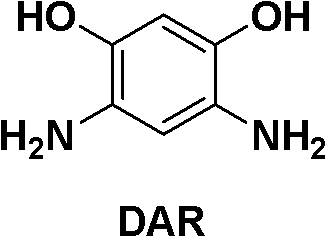Method for synthesizing 4,6-diamino resorcinol dihydrochloride (DAR)
A technology of diaminoresorcinol hydrochloride and dinitro, which is applied in the field of synthesis, can solve problems such as difficult industrial production and application, catalyst recycling, and difficult industrial production, so as to facilitate large-scale application, The effect of small reaction corrosion and simple method
- Summary
- Abstract
- Description
- Claims
- Application Information
AI Technical Summary
Problems solved by technology
Method used
Image
Examples
Embodiment 1
[0026]
[0027] Add 500 grams of concentrated sulfuric acid in 2 liters of reactors, heat up to 80 degrees, start to slowly add 294 grams of m-dichlorobenzene, and keep warm for 6 hours. Then use ice water to cool the system to about 40 degrees, add 70 grams of concentrated nitric acid dropwise, the reaction is violently exothermic, use cold water to cool down, pay attention to control the temperature below 50 degrees, and keep the temperature for 10 hours. After the reaction is over, cool to room temperature. The nitration reaction solution was slowly added to 3000 grams of ice water for dilution, the temperature was controlled at 40 degrees downward, and after stirring for about half an hour, crystals gradually precipitated, filtered and washed with water, dried to obtain a crude product and recrystallized with methanol to obtain 4 , 450 grams of 6-dinitro-m-dichlorobenzene, HPLC purity analysis> 96%, product yield is 95%.
[0028]
[0029] Add 237 grams of 4,6-dinitro...
Embodiment 2
[0035] In step (1), concentrated sulfuric acid mass concentration is 80-98% (example 80%, 90%, 98%), and consumption is 2-15 times (example 2,8,15 times) of m-dichlorobenzene by weight Concentrated nitric acid mass concentration is 50-100% (example 50%, 75%, 100%), and consumption is 2-8 times (example 2,5,8 times) of m-dichlorobenzene by weight, and the temperature of reaction is 0~40°C (eg 2°C, 20°C, 40°C).
[0036] Alcohol solvent is methyl alcohol, ethanol or propanol in the step (2), and the volume ratio of alcohol solvent and water is 3: 1-20: 1 (example 3: 1, 1: 1, 1: 20), and temperature of reaction is 40- 80°C (eg 40°C, 60°C, 80°C).
[0037] The molar consumption of selenium is 0.1-10% (example 0.1%, 5%, 10%) of substrate in the step (3), and the molar consumption of alkali is 0-300% (example 0%, 150%, 300% of substrate) %), reaction temperature is controlled at 60-200 ℃ (example 60 ℃, 160 ℃, 200 ℃), and reaction pressure is controlled at 1-8Mpa (example 1Mpa, 5Mpa,...
PUM
| Property | Measurement | Unit |
|---|---|---|
| tensile strength | aaaaa | aaaaa |
| density | aaaaa | aaaaa |
Abstract
Description
Claims
Application Information
 Login to View More
Login to View More - R&D
- Intellectual Property
- Life Sciences
- Materials
- Tech Scout
- Unparalleled Data Quality
- Higher Quality Content
- 60% Fewer Hallucinations
Browse by: Latest US Patents, China's latest patents, Technical Efficacy Thesaurus, Application Domain, Technology Topic, Popular Technical Reports.
© 2025 PatSnap. All rights reserved.Legal|Privacy policy|Modern Slavery Act Transparency Statement|Sitemap|About US| Contact US: help@patsnap.com



